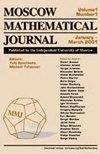电网络,拉格朗日格拉斯曼和辛群
IF 0.5
4区 数学
Q3 MATHEMATICS
引用次数: 6
摘要
我们改进了T.Lam\cite{L}关于将具有$n$边界点的平面图上的网络空间$E_n$嵌入到完全非负Grassmannian$\mathrm中的结果{Gr}_{\geq 0}(n-1,2n)$,首先证明图像落在$\mathrm{Gr}(n-1,V)\subet \mathrm}(n,2n)$中,其中$V\subet \athbb{R}^{2n}$是维数为$2n-2$的某个子空间。这种降低环境空间维度的作用对我们来说至关重要。接下来,我们展示了图像实际上落在拉格朗日Grassmannian$\mathrm{LG}(n-1,V)\subet \mathrm{Gr}(n-1,V)$内。众所周知,$\mathrm{LG}(n-1)$可以用$\mathrm{Gr}(n-1,2n-2)\cap\mathbb{P}L$来识别,其中$L\subet\bigwedge^{n-1}\mathbb R^{2n-2}$是一个维数等于加泰罗尼亚语数$C_n$的子空间,而且它是辛群$Sp(2n-2)$的基本表示的空间,它对应于Dynkin图的最后一个顶点。我们进一步证明了从\cite{L}中找到的$\mathrm{Gr}(n-1,2n)$中截取$E_n$的图像的线性关系定义了$L$空间。这将在{L}中发现的$E_n$的组合描述与辛群的表示理论联系起来。本文章由计算机程序翻译,如有差异,请以英文原文为准。
Electrical Networks, Lagrangian Grassmannians, and Symplectic Groups
We refine the result of T. Lam \cite{L} on embedding the space $E_n$ of electrical networks on a planar graph with $n$ boundary points into the totally non-negative Grassmannian $\mathrm{Gr}_{\geq 0}(n-1,2n)$ by proving first that the image lands in $\mathrm{Gr}(n-1,V)\subset \mathrm{Gr}(n-1,2n)$ where $V\subset \mathbb{R}^{2n}$ is a certain subspace of dimension $2n-2$. The role of this reduction in the dimension of the ambient space is crucial for us. We show next that the image lands in fact inside the Lagrangian Grassmannian $\mathrm{LG}(n-1,V)\subset \mathrm{Gr}(n-1,V)$. As it is well known $\mathrm{LG}(n-1)$ can be identified with $\mathrm{Gr}(n-1,2n-2)\cap \mathbb{P} L$ where $L\subset \bigwedge^{n-1}\mathbb R^{2n-2}$ is a subspace of dimension equal to the Catalan number $C_n$, moreover it is the space of the fundamental representation of the symplectic group $Sp(2n-2)$ which corresponds to the last vertex of the Dynkin diagram. We show further that the linear relations cutting the image of $E_n$ out of $\mathrm{Gr}(n-1,2n)$ found in \cite{L} define that space $L$. This connects the combinatorial description of $E_n$ discovered in \cite{L} and representation theory of the symplectic group.
求助全文
通过发布文献求助,成功后即可免费获取论文全文。
去求助
来源期刊
CiteScore
1.40
自引率
0.00%
发文量
16
审稿时长
>12 weeks
期刊介绍:
The Moscow Mathematical Journal (MMJ) is an international quarterly published (paper and electronic) by the Independent University of Moscow and the department of mathematics of the Higher School of Economics, and distributed by the American Mathematical Society. MMJ presents highest quality research and research-expository papers in mathematics from all over the world. Its purpose is to bring together different branches of our science and to achieve the broadest possible outlook on mathematics, characteristic of the Moscow mathematical school in general and of the Independent University of Moscow in particular.
An important specific trait of the journal is that it especially encourages research-expository papers, which must contain new important results and include detailed introductions, placing the achievements in the context of other studies and explaining the motivation behind the research. The aim is to make the articles — at least the formulation of the main results and their significance — understandable to a wide mathematical audience rather than to a narrow class of specialists.

 求助内容:
求助内容: 应助结果提醒方式:
应助结果提醒方式:


